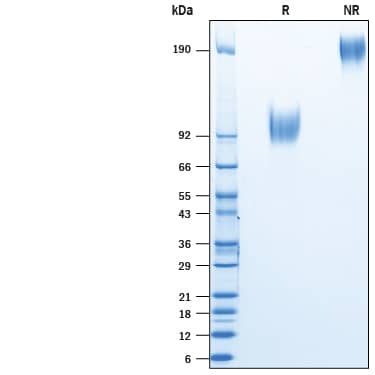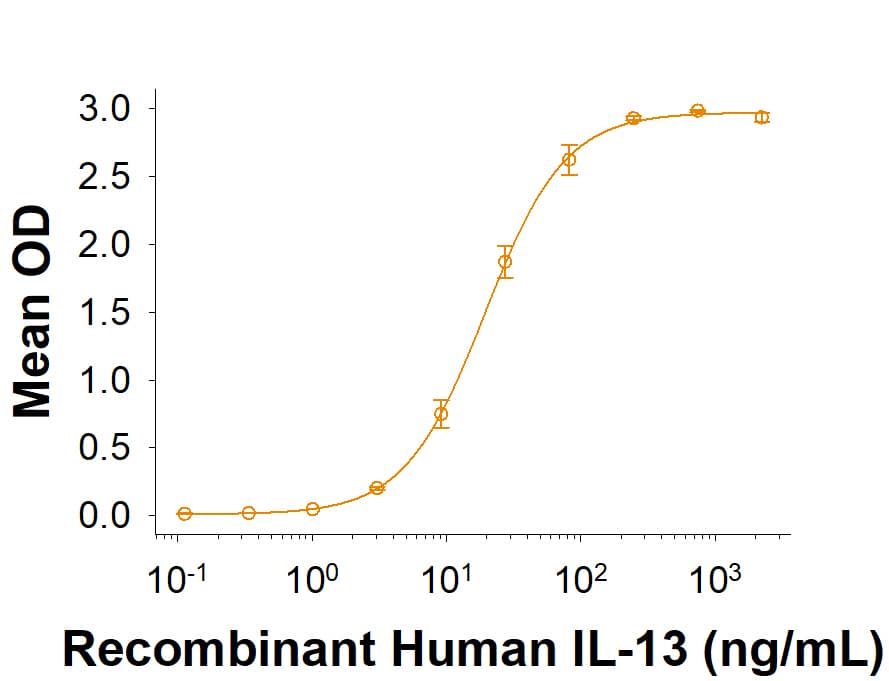Recombinant Human IL-13 R alpha 1 Fc Avi-tag Protein, CF
R&D Systems, part of Bio-Techne | Catalog # AVI10436
Biotinylated

Key Product Details
Learn more about Avi-tag Biotinylated Proteins
Source
CHO
Accession #
Structure / Form
Biotinylated via Avi-tag
Conjugate
Biotin
Applications
Bioactivity
Product Specifications
Source
Chinese Hamster Ovary cell line, CHO-derived human IL-13 R alpha 1 protein
| Human IL-13 R alpha1 (Ala27-Thr343) Accession # AAB37127.1 |
IEGRMD | Human IgG1 (Pro100-Lys330) |
Avi-tag |
| N-terminus | C-terminus | ||
Purity
>95%, by SDS-PAGE visualized with Silver Staining and quantitative densitometry by Coomassie® Blue Staining.
Endotoxin Level
<0.10 EU per 1 μg of the protein by the LAL method.
N-terminal Sequence Analysis
Ala27
Predicted Molecular Mass
65 kDa
SDS-PAGE
93-103 kDa, under reducing conditions
Activity
Measured by its binding ability in a functional ELISA.
When Biotinylated Recombinant Human IL-13 R alpha1 Fc Chimera Avi-tag (Catalog # AVI10436) is immobilized at 1 µg/mL (100 µL/well), Recombinant Human IL-13 (Catalog # 213-ILB) binds with an ED50 of 10-80 ng/mL.
When Biotinylated Recombinant Human IL-13 R alpha1 Fc Chimera Avi-tag (Catalog # AVI10436) is immobilized at 1 µg/mL (100 µL/well), Recombinant Human IL-13 (Catalog # 213-ILB) binds with an ED50 of 10-80 ng/mL.
Scientific Data Images for Recombinant Human IL-13 R alpha 1 Fc Avi-tag Protein, CF
Biotinylated Human IL-13 R alpha 1 Fc Chimera Avi-tag Protein Binding Activity.
When Biotinylated Recombinant Human IL-13 R alpha1 Fc Chimera Avi-tag (Catalog # AVI10436) is immobilized at 1 µg/mL (100 µL/well), Recombinant Human IL-13 (213-ILB) binds with an ED50 of 10-80 ng/mL.Biotinylated Recombinant Human IL-13 R alpha 1 Fc Chimera Avi-tag Protein SDS-PAGE.
2 μg/lane of Biotinylated Recombinant Human IL-13 R alpha1 Fc Chimera Avi-tag (Catalog # AVI10436) was resolved with SDS-PAGE under reducing (R) and non-reducing (NR) conditions and visualized by Coomassie® Blue staining, showing bands at 93-103 kDa and 186-206 kDa, respectively.Formulation, Preparation and Storage
AVI10436
| Formulation | Supplied as a 0.2 μm filtered solution in PBS with Trehalose. |
| Shipping | The product is shipped with dry ice or equivalent. Upon receipt, store it immediately at the temperature recommended below. |
| Stability & Storage | Use a manual defrost freezer and avoid repeated freeze-thaw cycles.
|
Background: IL-13 R alpha 1
References
- Aman M.J. et al. (1996) J. Biol. Chem. 271:29265.
- LaPorte S.L. et al. (2008) Cell 132:259.
- Arima K. et al. (2005) J. Biol. Chem. 280:24915.
- Ito T, et al. (2009) J. Biol. Chem. 284:24289.
- Umeshita-Suyama R. et al. (2000) Int. Immunol. 12:1499.
- Roy B, et al. (2002) J. Leukoc. Biol. 72:580.
- Osawa M, et al. (2000) Immunogenetics 51:974.
- Rachmin I, et al. (2017) Am. J. Physiol. Endocrinol. Metab. 313:E663.
- Park M.H. et al. (2017) Ann, Surg. Oncol. 24:3780.
- Cao H, et al. (2016) Oncotarget 7:61183.
- Suzuki A, et al. (2015) Cytokine 75:79.
Long Name
Interleukin 13 Receptor alpha 1
Alternate Names
CD213a1, IL-13Ra1, IL13R alpha 1, IL13RA1
Gene Symbol
IL13RA1
UniProt
Additional IL-13 R alpha 1 Products
Product Documents for Recombinant Human IL-13 R alpha 1 Fc Avi-tag Protein, CF
Product Specific Notices for Recombinant Human IL-13 R alpha 1 Fc Avi-tag Protein, CF
For research use only
